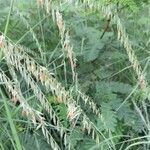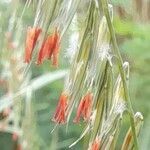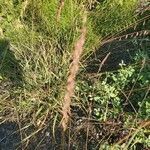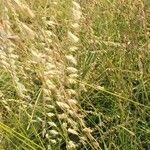Erect perennial 3–10 dm from short slender rhizomes; sheaths smooth or nearly so; ligule a band of short hairs; blades elongate, 2–7 mm wide, scabrous on the margins; spikes (10–)40–70, spreading or nodding, 8–15 mm, secund along an axis 1–3 dm, falling entire; spikelets usually 3–7; first glume linear-subulate, 3–4 mm; second glume lanceolate, 4–7 mm; fertile lemma usually somewhat exceeding the glumes, acuminate, its lateral veins prolonged into awns 1 mm; vestige with a long central awn and 2 shorter lateral ones arising below the middle, or much reduced or obsolete; 2n=20–103. Dry woods in the e. states, and dry prairies and sand-hills in the w.; Me. to Mont., s. to Ala., Calif., and C. and S. Amer. (Atheropogon c.) Ours is var. curtipendula.




